 If you’ve noticed that your lawn isn’t looking so good lately, it may be time to consider professional lawn care. Even a well-maintained, healthy lawn can develop a variety of problems that can quickly turn a gorgeous, green turf into a neighborhood eyesore. By addressing your lawn problems with professional help, you can quickly restore your landscape to its natural beauty and create an inviting entrance to your home.
If you’ve noticed that your lawn isn’t looking so good lately, it may be time to consider professional lawn care. Even a well-maintained, healthy lawn can develop a variety of problems that can quickly turn a gorgeous, green turf into a neighborhood eyesore. By addressing your lawn problems with professional help, you can quickly restore your landscape to its natural beauty and create an inviting entrance to your home.
Common Lawn Problems
No lawn is immune to various problems caused by weather or climate conditions, fungal diseases, insects and weeds. If your lawn develops any of these problems, it’s best to tackle the problem as soon as possible to keep it from getting worse. You may need professional lawn care help from a qualified landscape contractor to restore your lawn to a healthy state.
Take a look at some common problems that can plague your healthy lawn:
Weather and Climate Conditions
Whether you live in a sunny, warm Florida climate or in the cold winter temperatures of Northern New Jersey, your lawn is subject to weather and climate conditions that can cause problems. To avoid many of these problems, make sure you plant a type of grass that’s recommended by a professional lawn care expert for your location and climate conditions.
- Cool-Season Grasses: Cool-season grasses include tall and fine fescues, Kentucky bluegrass and perennial ryegrass. These grasses grow best in the moderate temperatures of spring and fall. In cooler climate areas, they go dormant and turn brown in summer.
- Warm-Season Grasses: Warm-season grasses, like Bermuda grass, buffalo grass and zoysia, can easily invade a cool-season lawn. From fall through late spring, warm-season grasses can cause brown patches in an otherwise green lawn. During summer, they are green and growing.
Heat and Drought Stress
Heat and drought are two of the most common reasons why cool-season lawns turn brown in the summer, because they typically go dormant when subjected to warm weather conditions.
Fine fescues and Kentucky bluegrass are the first to go dormant, followed by tall fescues and perennial ryegrass. Most lawns contain a mixture of grasses and dormant grasses leave brown patches and thinning areas in the lawn. Although dormant grasses will turn green again when early fall rains and cooler temperatures arrive, they have an increased risk of disease and insect problems that will need professional lawn care.
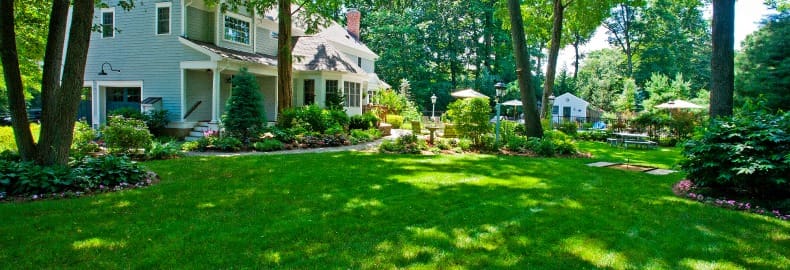
Shade and Tree Cover
When grass is subjected to shade and tree cover, it can become thin and malnourished from lack of ample light and moisture. It will never look as lush and green as grass growing in full sun. Some grasses, like varieties of fine fescues, tolerate shade better, but they become subject to shade-loving weeds.
Watering will help dry conditions, but wet, shady areas are more prone to fungal diseases, like pythium blight and ring spot. Research studies show that the roots of some trees, like silver maple, produce a chemical that actually hurts the growth of Kentucky bluegrass.
Dry Slopes and Hillsides
If your Bergen County, NJ landscape has sunny, south or west-facing slopes or hillsides, you need warm-season grasses in those areas. Cool-season grasses will go dormant in sunny locations and are often killed by heat and drought.
Slopes and hilly areas are also hard to irrigate, but they require frequent watering in summer heat. A professional lawn care expert can help with special irrigation methods in hard to water areas to facilitate water uptake and prevent runoff.
Soil Compaction
Grass does not grow well in soil that has been compacted by foot traffic or vehicles. If your landscape has compacted soil, talk to a professional lawn care provider about loosening or aerating the soil, so new sod or seed can be applied in late summer or early fall before cold weather arrives.
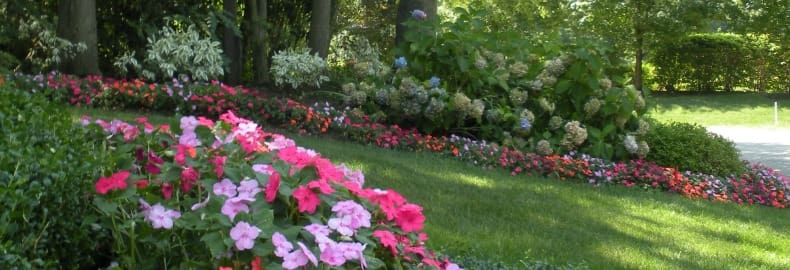
Fungal Diseases
Although lawns do get attacked by viruses and bacteria, most lawn diseases are caused by various types of fungi. Fungal spores live on grass blades, the thatch layer and topsoil. When your lawn is weakened by lack of nutrients, wet or dry weather and improper lawn maintenance, fungal spores invade your lawn.
Spores can be spread by wind, rain, insects, contaminated soil and people walking around on the grass when it’s wet. Here are common fungal diseases that require professional lawn care help:
- Dollar Spot: This fungus appears as tan or straw-colored spots that resemble silver dollars and thrives on malnourished, dry lawns. Small, white, cobweb-like spots appear in the morning and turn brown later in the day. Infected spots can increase in number, but never attach.
- Plythium Blight: Plythium Blight usually invades newly seeded lawns in spring or fall. It causes blackened, water-soaked patches of flattened grass blades from 2 to 6 inches in diameter up to 2 feet across. Grass usually dies within 24 hours and new grass does not grow back.
- Fusarium Patch: This fungus appears during late winter and early spring. It causes circular patches of dead grass from 1 to 3 inches across or larger. It’s also known as Pink Snow Mold because grass is covered with a white to pink mold after winter snows melt.
- Rust: Rust fungus appears on grass blades and stems in late summer. Grass blades turn orange or reddish-brown and as the fungus progresses they turn from brown to black. Grass becomes thin and infected areas turn yellow, wither and die. Professional lawn care help is necessary.
- Fairy Ring: Fairy Ring fungus causes bright-green circular areas in the lawn, usually appearing in spring or fall. This ring of over-stimulated growth may be 4 to 12 inches wide at first, but the ring can grow to 50 feet across. Patches of grass decline and mushrooms often grow.
- Mushrooms: Mushrooms are a common fungus growth in rainy weather. They thrive on decaying organic matter in the soil, but will not harm your lawn. They can be collected and composted, knocked down with a rake or mowed down with the lawnmower. Never collect and eat them, as they can be poisonous.
Insects
There’s a variety of insects that cause lawn problems. Since these insects live everywhere outdoors, they can be difficult to control or eliminate, and you will probably need a professional lawn care expert to help you with these problems.
Some common insects found in Northern NJ areas include:
- Army Worms: In the fall, you may notice bare areas in the lawn caused by army worms that resemble caterpillars. They usually feed at night and can eat the grass right down to the soil. Army worms can appear in large numbers and professional lawn care help is often needed to get rid of them.
- Chinch Bugs: In August and early September, you may see large, circular patches in the sunny areas of your lawn that turn yellow, then brown and then die. These patches often appear near borders of sidewalks and driveways that reflect heat onto the lawn. The yellowish spots, caused by chinch bugs, eventually spread outward into the rest of the lawn.
- Grubs: In June or early July, you may notice irregular brown patches of grass caused by grubs. Brown patches increase during the summer and are extensive by fall. Suspect a grub problem if turf appears scorched and sod lifts up easily in these spots due to destroyed root systems.
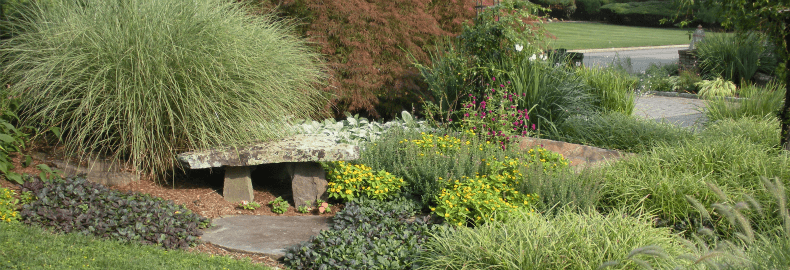
Weeds
Weeds are one of the hardest things to control in your lawn. A weed can be any plant that is growing in the lawn, even grass of a different species other than the one that was originally planted. There are so many different types of weeds, professional lawn care is recommended to get them under control.
Many landscape contractors offer organic lawn care that uses organic products for weed control, rather than harmful weed killers and pesticides that can be toxic to children and pets.
Some of the most common weeds in Bergen County, NJ landscapes include:
- Thatch: Thatch is made up of living and dead grass, roots, lower grass layers and organic debris on the soil’s surface. It looks like a layer of brown, tightly compressed, peat moss. It’s usually not a problem in fescue lawns, but causes problems in Kentucky bluegrass lawns in cooler, northern parts of the country. A thick layer of thatch invites insects and diseases.
- Dandelions: Although they produce cute little yellow flowers, dandelions are anything but cute. They grow rapidly in malnourished and ill-maintained lawns and require professional lawn care techniques to eliminate them from the yard. These hardy weeds are among the hardest to get rid of.
There’s a big variety of grassy weeds and broadleaf weeds that can easily invade your lawn. To keep your lawn green and healthy, work with a professional lawn care service that can provide regular lawn maintenance and keep annoying weed growth under control.
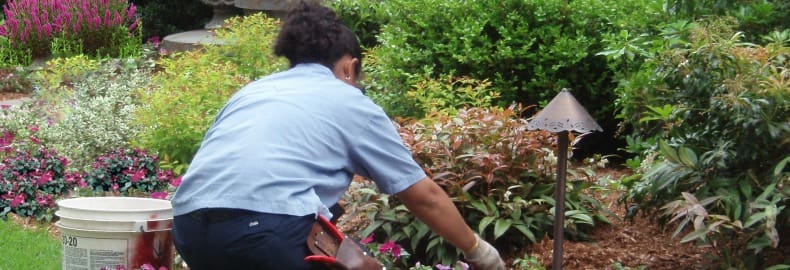
Improper Lawn Care
In addition to problems caused by weather and climate conditions, diseases, insects and weeds, you can actually damage your own lawn by using improper lawn maintenance procedures.
Mowing
Improper mowing can damage your lawn. A dull mower blade can give your grass a tan or brownish appearance from frayed or dead grass blades. Scalping, cutting the grass too short, makes the lawn look brown by removing too much leaf surface. It also increases soil temperature by exposing the soil to more sun which can force your grass to become dormant or die.
Watering
Improper watering, too much water and too little water, can cause a variety of problems for your lawn. Too much water can cause root rot, increased diseases and grub activity. Too little water can result in bare or brown patches, weeds and dead grass. A professional lawn care expert with knowledge and experience in proper lawn care will keep your lawn looking its best year-round.
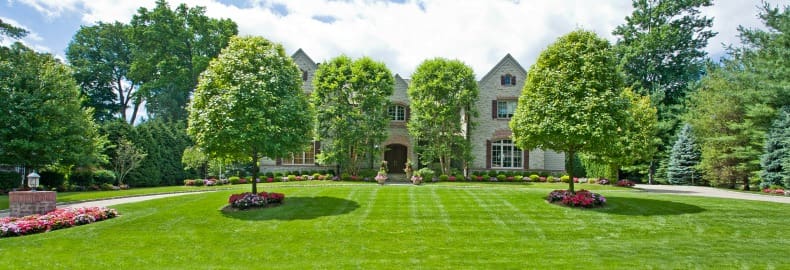
Fertilization
Careless or improper fertilizing can cause lawn problems, like brown spots or streaks. Applying too much nitrogen in the spring results in excessive top growth and poor root development which leaves your lawn more susceptible to summer drought, diseases and insects. In general, it’s best to use slow release fertilizers and apply fertilizer in the fall.
The Benefits of Professional Lawn Care
By hiring a professional landscape contractor to maintain your lawn on a regular basis, you can eliminate a lot of lawn problems. The best time to hire them is in early spring, so they can provide proper care after the long winter season when a lot of damage occurs to your lawn and landscape.
